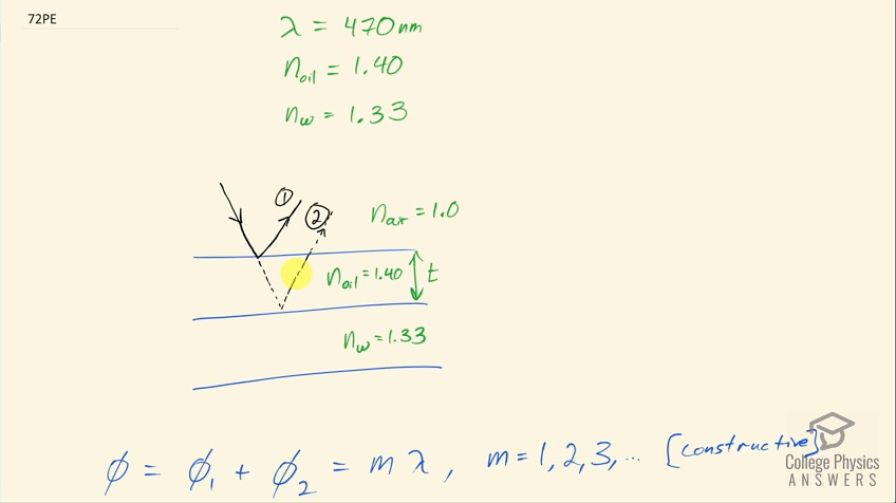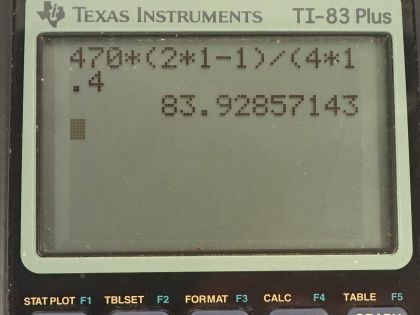Question
Calculate the minimum thickness of an oil slick on water that appears blue when illuminated by white light perpendicular to its surface. Take the blue wavelength to be 470 nm and the index of refraction of oil to be 1.40.
Final Answer
Solution video
OpenStax College Physics, Chapter 27, Problem 72 (Problems & Exercises)

vote with a rating of
votes with an average rating of
.
Calculator Screenshots
Video Transcript
This is College Physics Answers with Shaun Dychko. An oil slick on water appears to be blue so blue is experiencing constructive interference, the wavelength of blue is 470 nanometers, the index of refraction of the oil is 1.40 and the index of refraction of water we know is 1.33. So this ray of light is coming in at an angle that's perpendicular but I am drawing it on an angle here just so that we can see the reflected rays more clearly. So the incident light is really coming down like this and then being reflected straight up and these two reflected rays are interfering and overlapping but in my drawing, I am drawing them at an angle here just so we can distinguish between them. So we have ray one being reflected from this interface between the air and the oil and then some of the light though doesn't get reflected and instead penetrates into the oil and then gets reflected from this interface between the oil and the water and then gets reflected back up and then these two rays constructively interfere for the wavelength blue. So what is the minimum thickness of this oil needed in order for that to happen? So... there's a phase difference between these two rays and that results in the constructive interference and that total phase difference which I label with this symbol Φ is going to be the phase shift of the first ray plus the phase shift of the second ray and this total has to be some natural number multiplied by the wavelength in the air. So the number of wavelengths phase shift for the first ray is half of a wavelength because there's reflection happening here at an interface where the ray begins in a low index of refraction of 1 and the second medium at this interface is a higher index of refraction of 1.40 and when the reflection occurs in that scenario, there's an automatic phase shift of half of a wavelength. Now at this interface here, when the light is going through the water and then reflecting off an interface where the second medium (or sorry... did I say water? that's oil actually) so this light ray is going through oil and then reflecting off the interface where the second medium is water it's going from a high index of refraction and then reflecting off an interface where the second medium has a lower index of refraction and so there is no phase shift due to reflection at this point. Okay! But this second ray is phase shifted as a result of the greater distance that it's traveling and so we want to know how many wavelengths is this distance? And so we take the thickness, which we are going to find and it's traveling this thickness twice and so we have 2 times the thickness— whatever the thickness is— divided by the wavelength but this wavelength is the wavelength in the oil so that's what this subscript n here means is it's the wavelength in this medium with some index of refraction and this fraction here is the number of wavelengths and then we multiply that by λ to get the phase shift in number of wavelengths and that is number of wavelengths in the air. Okay! So let's substitute for λ n it's going to be the wavelength in a vacuum or air, which is pretty much the same as in a vacuum divided by the index of refraction of the oil and since we are dividing by this fraction, I am going to multiply by its reciprocal and so we have 2 times the thickness multiplied by the index of refraction of oil divided by the wavelength in air. So this λ is the same as this one and they cancel and so the phase shift of the second ray then is 2 times the thickness multiplied by the index of refraction of the oil. So we can substitute for Φ 2 and Φ 1 and this all has to equal mλ and we are going to solve this for t eventually. First let's subtract λ over 2 from both sides and then we have 2 times the thickness times the index of refraction of oil equals mλ minus λ over 2 and then we can multiply this by 2 over 2 and then factor out the λ and we have λ times 2m minus 1 all over 2 and then divide both sides by 2 times the index of refraction and we end up with the thickness then is λ times 2m minus 1 all over 4 times the index of refraction of oil. Now we are meant to minimize the thickness we want to get the minimum possible thickness such that the blue light has constructive interference and so that means we take the smallest possible number for m, which is 1. So the thickness then is 470 nanometers and I guess I can put minimum here by the way so the minimum thickness is 470 nanometers times 2 times 1 minus 1 all over 4 times 1.40 and that is 83.9 nanometers.
